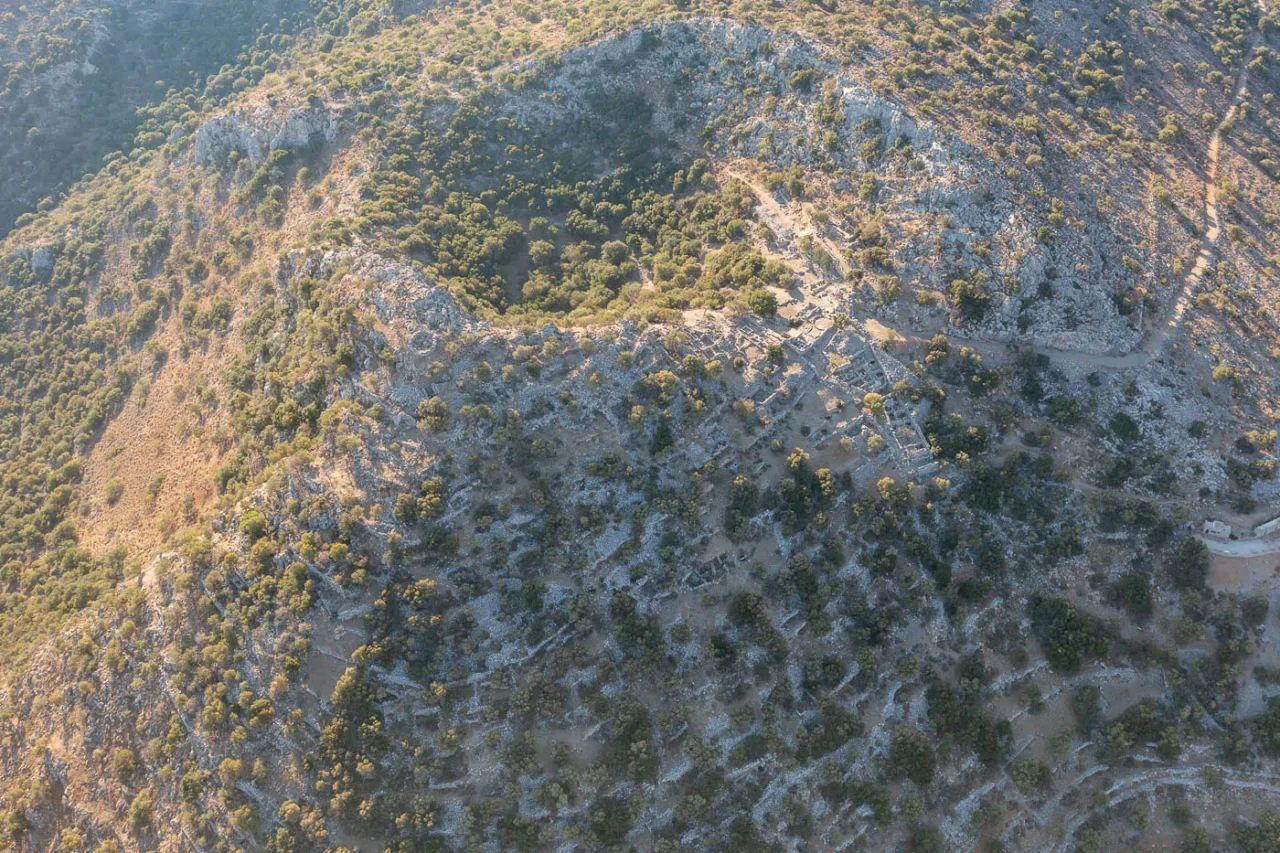
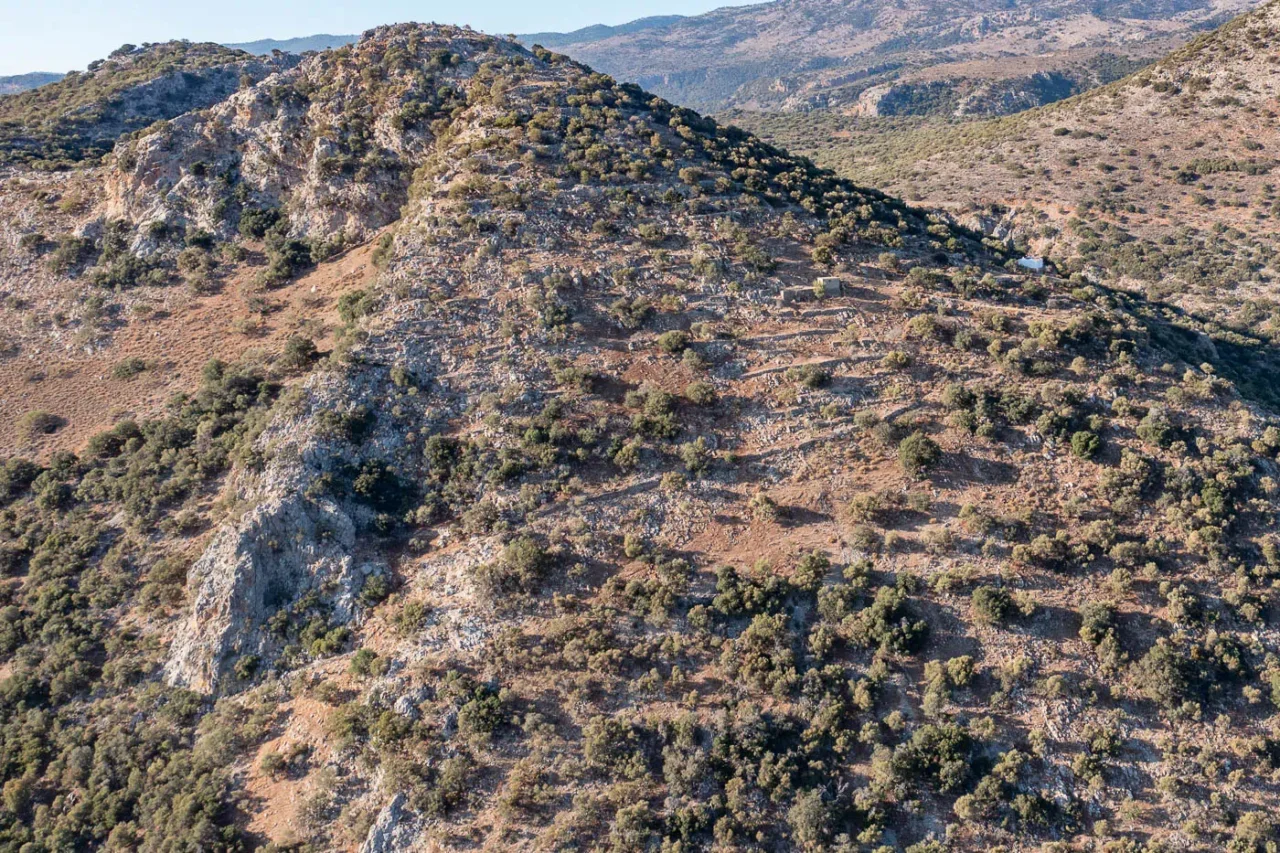
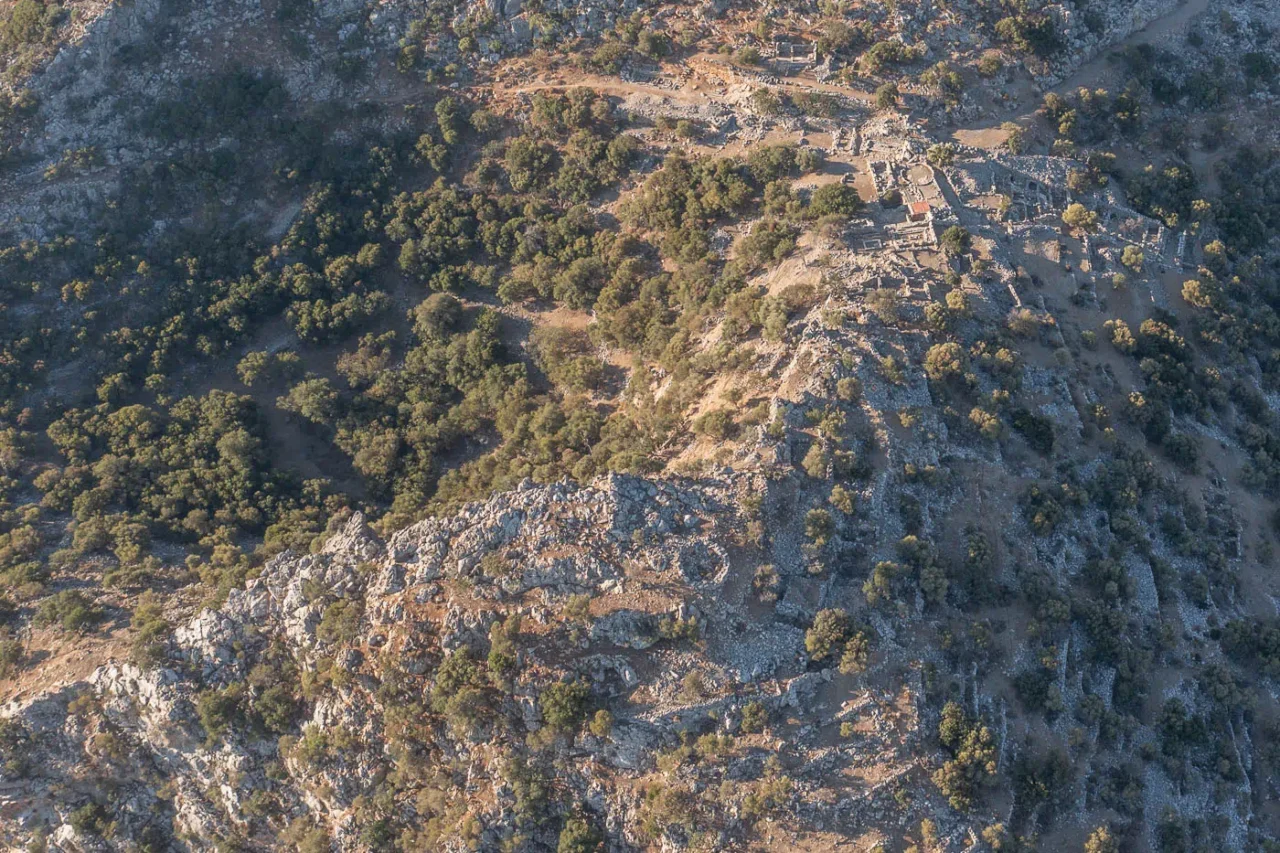
Lato, an ancient city nestled amidst the rugged terrain of Crete, near the present-day village of Kritsa, offers a captivating glimpse into the island’s rich history. Renowned for its exceptional preservation, Lato stands as a testament to the ingenuity and resilience of its ancient inhabitants. The city’s strategic hilltop position, affording breathtaking vistas of the Mirabello Gulf, not only provided a natural defense but also solidified its prominence in the region.
Origins and Name
The city’s roots extend deep into the Minoan era, though it reached its zenith in the aftermath of the Dorian arrival. The name “Lato” is believed to have sprung from the Doric interpretation of the goddess Leto, mother of Apollo and Artemis, who was likely venerated within the city’s walls. However, the official patron deity of Lato was Eileithyia, the goddess of childbirth, whose image was prominently featured on the city’s coinage. Adding to its historical significance, Lato was the birthplace of Nearchus, a celebrated admiral who served under Alexander the Great.
Strategic Importance and Power
Lato’s strategic hilltop location and formidable fortifications played a pivotal role in its ascension as one of the most powerful city-states in ancient Crete. The city’s influence extended far beyond its physical boundaries, as evidenced by the preserved agreements with neighboring cities, underscoring its active participation in regional politics and trade. Lato’s economic prosperity was further fueled by its maritime connections through its port, Lato pros Kamara, situated at the site of modern-day Agios Nikolaos. This bustling port served as a conduit for trade, facilitating the exchange of goods and ideas, and contributing significantly to the city’s growth and development.
Urban Landscape and Architecture
The archaeological site of Lato presents a remarkable window into the urban planning and architectural achievements of the Classical and Hellenistic periods. The city’s well-preserved remains showcase a harmonious blend of functionality and aesthetics, reflecting the ingenuity and skill of its ancient builders.
- Fortifications: The city’s robust defensive walls, punctuated by imposing gates and towers, stand as a testament to its military prowess and strategic significance. These fortifications not only protected the city from external threats but also projected an image of strength and resilience.
- Agora: The heart of Lato’s civic life, the agora served as a bustling marketplace and a focal point for social interaction. The agora’s well-defined layout and surrounding structures reflect the city’s economic vitality and its role as a center for trade and commerce.
- Prytaneion: The council house, or prytaneion, where city officials convened to discuss matters of governance, underscores Lato’s well-organized political structure. This building served as a symbol of the city’s commitment to democratic principles and civic participation.
- Theater: A small but well-preserved theater, nestled within the city’s slopes, likely hosted a variety of performances and gatherings, providing entertainment and cultural enrichment for the Latoans. The theater’s presence highlights the importance of the performing arts in the city’s social fabric.
- Temples: The remnants of temples dedicated to various deities, including the city’s patron goddess Eileithyia, offer insights into the religious beliefs and practices of the Latoans. These temples served as focal points for worship and ritual activities, fostering a sense of community and spiritual connection.
- Public Spaces and Infrastructure: The archaeological site also features remnants of cisterns, public buildings, and other essential infrastructure, providing a glimpse into the city’s organization and the daily lives of its inhabitants. These structures highlight the Latoans’ commitment to providing for the needs of their community and ensuring a comfortable and functional urban environment.
Life in Ancient Lato
The archaeological evidence suggests that Lato was a thriving and well-organized city, with a diverse population engaged in various economic activities. The city’s strategic location and access to maritime trade routes fostered a vibrant commercial sector, while its fertile hinterland supported agriculture and animal husbandry. The presence of public spaces, such as the agora and theater, indicates a rich social and cultural life, with opportunities for entertainment, civic engagement, and religious observance.
The discovery of numerous private houses, ranging from modest dwellings to more elaborate structures, provides further insights into the daily lives of the Latoans. These houses, often equipped with courtyards, cisterns, and other amenities, reflect the varying social and economic statuses of their inhabitants. The presence of workshops and industrial areas suggests a diverse range of crafts and industries, contributing to the city’s economic self-sufficiency.
Decline and Rediscovery
Lato’s decline began in the Roman era, as the center of power shifted towards coastal cities like Lato pros Kamara. The city was eventually abandoned, its once-bustling streets and structures falling into ruin. However, the site’s remote location and the durable nature of its construction materials ensured its remarkable preservation.
In the late 19th and early 20th centuries, archaeologists began to excavate Lato, uncovering its hidden treasures and revealing its architectural splendor. The site quickly gained recognition as one of the best-preserved examples of a Classical–Hellenistic city in Greece, attracting scholars and visitors from around the world.
Lato Today
Today, Lato stands as an open-air museum, inviting visitors to step back in time and explore the remnants of this once-thriving city. The site’s well-preserved ruins, combined with its stunning natural setting, offer a unique and immersive experience, allowing visitors to connect with the past and gain a deeper appreciation for the achievements of ancient civilizations.
Lato’s significance extends beyond its archaeological value. The city’s association with Nearchus, the renowned admiral of Alexander the Great, adds another layer of historical intrigue. Nearchus’s birthplace serves as a reminder of Lato’s role in shaping the course of history, its citizens contributing to the broader tapestry of ancient Greek civilization.
Archaeological Site: Key Points
- Construction Period: Primarily Classical and Hellenistic periods (5th-1st centuries BC), with evidence of earlier Minoan occupation.
- Location: Hilltop location near Kritsa, Crete, overlooking the Mirabello Gulf.
- Dimensions: The archaeological site covers a significant area, encompassing various public and private structures.
- Historical Significance: A powerful city-state in ancient Crete, known for its strategic location, strong fortifications, and maritime trade. Birthplace of Nearchus, admiral of Alexander the Great.
- Current Status: Well-preserved archaeological site and popular tourist destination, offering insights into Classical-Hellenistic urban life in Crete.
- Combined ticket: €15 (3-day duration) for the Archaeological Museum of Agios Nikolaos, Spinalonga, the Archaeological Site of Lato, the Church of Panagia Kera in Kritsa. Valid from 1st April to 31st October.
References
- Stampolidis, Nicholas Chr.; Tsangari, Dimitra I.; Giannopoulou, Mimika (2019). Cretan Cities: The Testimony of Coins. Alpha Bank, University of Crete, Ephorate of Antiquities of Rethymno, Museum of Ancient Eleutherna
- Karambinis, Michalis (2022). The cities of Crete under Roman rule (1st–3rd centuries AD). Journal of Greek Archaeology 7
- Antonis Thomas Vasilakis. The 147 Cities of Ancient Crete.
Notes for the opening hours
Access
People with disabilities can access the site by car via a special road leading to a secondary entrance and a viewing area. Wheelchairs cannot move around within the site due to its terrain. Parking and toilets for people with disabilities are available at the main entrance.














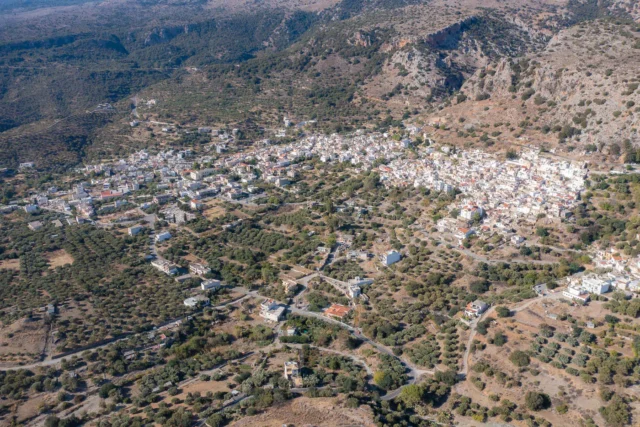
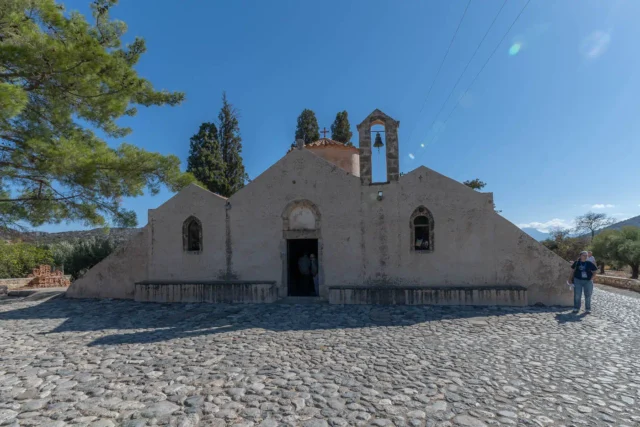



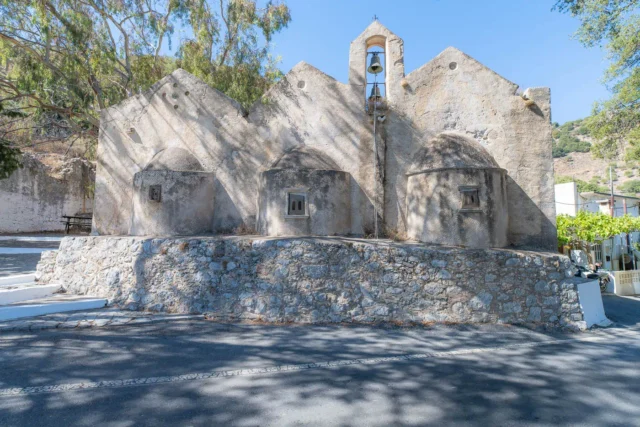
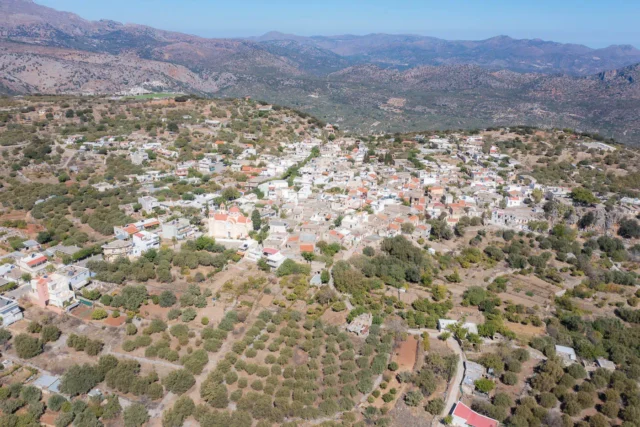


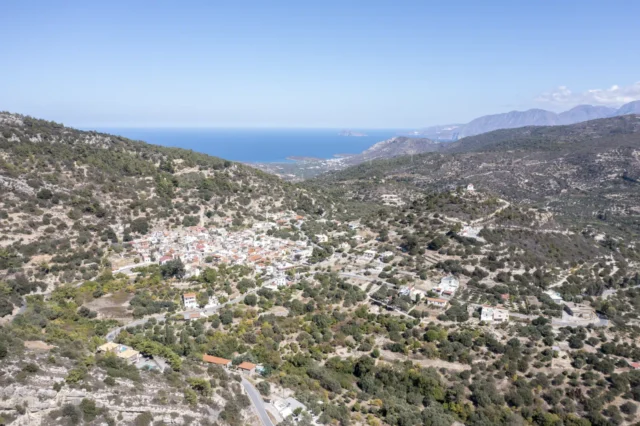


There are no comments yet.